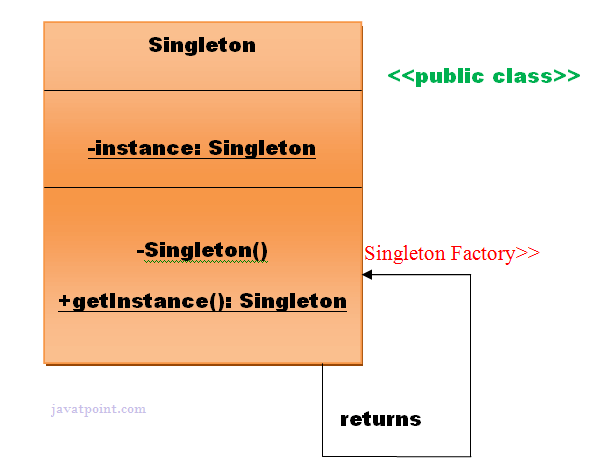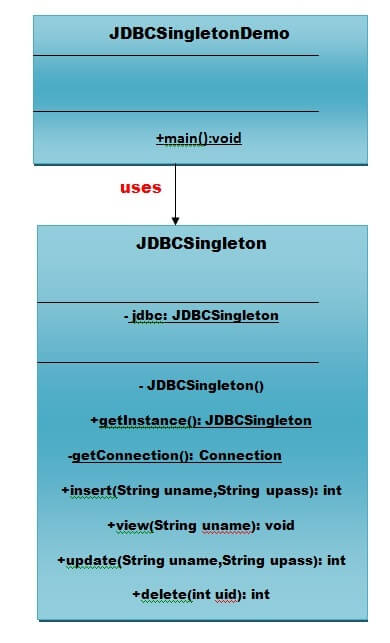Singleton design pattern
Singleton Pattern says that just“define a class that has only one instance and provides a global point of access to it”.
In other words, a class must ensure that only single instance should be created and single object can be used by all other classes.
There are two forms of singleton design pattern
- Early Instantiation: creation of instance at load time.
- Lazy Instantiation: creation of instance when required.
Advantage of Singleton design pattern
- Saves memory because object is not created at each request. Only single instance is reused again and again.
Usage of Singleton design pattern
- Singleton pattern is mostly used in multi-threaded and database applications. It is used in logging, caching, thread pools, configuration settings etc.
Uml of Singleton design pattern

How to create Singleton design pattern?
To create the singleton class, we need to have static member of class, private constructor and static factory method.
- Static member: It gets memory only once because of static, itcontains the instance of the Singleton class.
- Private constructor: It will prevent to instantiate the Singleton class from outside the class.
- Static factory method: This provides the global point of access to the Singleton object and returns the instance to the caller.
Understanding early Instantiation of Singleton Pattern
In such case, we create the instance of the class at the time of declaring the static data member, so instance of the class is created at the time of classloading.
Let’s see the example of singleton design pattern using early instantiation.
Example:
class A {
private static A obj = new A();// Early, instance will be created at load time
privateA() {
}
publicstaticA getA() {
return obj;
}
public void doSomething() {
// write your code
}
}
Understanding lazy Instantiation of Singleton Pattern
In such case, we create the instance of the class in synchronized method or synchronized block, so instance of the class is created when required.
Let’s see the simple example of singleton design pattern using lazy instantiation.
class A {
privatestaticA obj;
privateA() {
}
public static A getA() {
if(obj == null) {
synchronized(Singleton.class) {
if (obj == null) {
obj = new Singleton();// instance will be created at request time
}
}
}
returnobj;
}
public void doSomething() {
// write your code
}
}
Significance of Classloader in Singleton Pattern
If singleton class is loaded by two classloaders, two instance of singleton class will be created, one for each classloader.
Significance of Serialization in Singleton Pattern
If singleton class is Serializable, you can serialize the singleton instance. Once it is serialized, you can deserialize it but it will not return the singleton object.
To resolve this issue, you need to override the readResolve() method that enforces the singleton. It is called just after the object is deserialized. It returns the singleton object.
public class A implements Serializable {
// your code of singleton
protected Object readResolve() {
return getA();
}
}
Understanding Real Example of Singleton Pattern
- We are going to create a JDBCSingleton class. This JDBCSingleton class contains its constructor as private and a private static instance jdbc of itself.
- JDBCSingleton class provides a static method to get its static instance to the outside world. Now, JDBCSingletonDemo class will use JDBCSingleton class to get the JDBCSingleton object.

Assumption: you have created a table userdata that has three fields uid, uname and upassword in mysql database. Database name is ashwinirajput, username is root, password is ashwini.
import java.io.BufferedReader;
import java.io.IOException;
import java.io.InputStreamReader;
import java.sql.Connection;
import java.sql.DriverManager;
import java.sql.PreparedStatement;
import java.sql.ResultSet;
import java.sql.SQLException;
class JDBCSingleton {
// Step 1
// create a JDBCSingleton class.
// static member holds only one instance of the JDBCSingleton class.
privatestaticJDBCSingleton jdbc;
// JDBCSingleton prevents the instantiation from any other class.
private JDBCSingleton() {
}
// Now we are providing gloabal point of access.
public static JDBCSingleton getInstance() {
if(jdbc == null) {
jdbc = new JDBCSingleton();
}
returnjdbc;
}
// to get the connection from methods like insert, view etc.
private static Connection getConnection() throws ClassNotFoundException, SQLException {
Connection con = null;
Class.forName(“com.mysql.jdbc.Driver”);
con = DriverManager.getConnection(“jdbc:mysql://localhost:3306/ashwanirajput”, “root”, “ashwani”);
returncon;
}
// to insert the record into the database
public int insert(String name, String pass) throws SQLException {
Connection c = null;
PreparedStatement ps = null;
int recordCounter = 0;
try{
c = this.getConnection();
ps = c.prepareStatement(“insert into userdata(uname,upassword)values(?,?)”);
ps.setString(1, name);
ps.setString(2, pass);
recordCounter = ps.executeUpdate();
} catch (Exception e) {
e.printStackTrace();
} finally {
if (ps != null) {
ps.close();
}
if (c != null) {
c.close();
}
}
return recordCounter;
}
//to view the data from the database
public void view(String name) throws SQLException {
Connection con = null;
PreparedStatement ps = null;
ResultSet rs = null;
try{
con = this.getConnection();
ps = con.prepareStatement(“select * from userdata where uname=?”);
ps.setString(1, name);
rs = ps.executeQuery();
while (rs.next()) {
System.out.println(“Name= “ + rs.getString(2) + “\t” + “Paasword= “ + rs.getString(3));
}
} catch (Exception e) {
System.out.println(e);
} finally {
if (rs != null) {
rs.close();
}
if (ps != null) {
ps.close();
}
if (con != null) {
con.close();
}
}
}
// to update the password for the given username
public int update(String name, String password) throws SQLException {
Connection c = null;
PreparedStatement ps = null;
int recordCounter = 0;
try{
c = this.getConnection();
ps = c.prepareStatement(” update userdata set upassword=? where uname='” + name + “‘ “);
ps.setString(1, password);
recordCounter = ps.executeUpdate();
} catch (Exception e) {
e.printStackTrace();
} finally {
if (ps != null) {
ps.close();
}
if (c != null) {
c.close();
}
}
return recordCounter;
}
// to delete the data from the database
publicintdelete(int userid) throws SQLException {
Connection c = null;
PreparedStatement ps = null;
int recordCounter = 0;
try{
c = this.getConnection();
ps = c.prepareStatement(” delete from userdata where uid='” + userid + “‘ “);
recordCounter = ps.executeUpdate();
} catch (Exception e) {
e.printStackTrace();
} finally {
if (ps != null) {
ps.close();
}
if (c != null) {
c.close();
}
}
return recordCounter;
}
}// End of JDBCSingleton class
mport java.io.BufferedReader;
import java.io.IOException;
import java.io.InputStreamReader;
import java.sql.Connection;
import java.sql.DriverManager;
import java.sql.PreparedStatement;
import java.sql.ResultSet;
import java.sql.SQLException;
class JDBCSingletonDemo{
static int count=1;
static int choice;
public static void main(String[] args) throws IOException {
JDBCSingleton jdbc= JDBCSingleton.getInstance();
BufferedReader br=new BufferedReader(new InputStreamReader(System.in));
do{
System.out.println(“DATABASE OPERATIONS”);
System.out.println(” ——————— “);
System.out.println(” 1. Insertion “);
System.out.println(” 2. View “);
System.out.println(” 3. Delete “);
System.out.println(” 4. Update “);
System.out.println(” 5. Exit “);
System.out.print(“\n”);
System.out.print(“Please enter the choice what you want to perform in the database: “);
choice=Integer.parseInt(br.readLine());
switch(choice) {
case 1:{
System.out.print(“Enter the username you want to insert data into the database: “);
String username=br.readLine();
System.out.print(“Enter the password you want to insert data into the database: “);
String password=br.readLine();
try {
int i= jdbc.insert(username, password);
if (i>0) {
System.out.println((count++) + ” Data has been inserted successfully”);
}else{
System.out.println(“Data has not been inserted “);
}
} catch (Exception e) {
System.out.println(e);
}
System.out.println(“Press Enter key to continue…”);
System.in.read();
}//End of case 1
break;
case 2:{
System.out.print(“Enter the username : “);
String username=br.readLine();
try {
jdbc.view(username);
} catch (Exception e) {
System.out.println(e);
}
System.out.println(“Press Enter key to continue…”);
System.in.read();
}//End of case 2
break;
case 3:{
System.out.print(“Enter the userid, you want to delete: “);
int userid=Integer.parseInt(br.readLine());
try {
int i= jdbc.delete(userid);
if (i>0) {
System.out.println((count++) + ” Data has been deleted successfully”);
}else{
System.out.println(“Data has not been deleted”);
}
} catch (Exception e) {
System.out.println(e);
}
System.out.println(“Press Enter key to continue…”);
System.in.read();
}//End of case 3
break;
case 4:{
System.out.print(“Enter the username, you want to update: “);
String username=br.readLine();
System.out.print(“Enter the new password “);
String password=br.readLine();
try {
int i= jdbc.update(username, password);
if (i>0) {
System.out.println((count++) + ” Data has been updated successfully”);
}
} catch (Exception e) {
System.out.println(e);
}
System.out.println(“Press Enter key to continue…”);
System.in.read();
}// end of case 4
break;
default:
return;
}
} while (choice!=4);
}
}